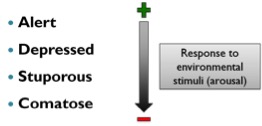Mental Status
Mental status is considered the way an animal responses to the environmental stimuli, so the level of arousal or consciousness. The two anatomical structures involved in maintaining the level of arousal are the ascending reticular activating system (ARAS) located in the brainstem, and the thalamo-cortex. The ARAS collects sensory information from spinal cord and cranial nerves and projects stimulatory input diffusely to the thalamo-cortex to maintain a normal mental status.
The mental status is mostly assessed observing how the patient interacts with the surrounding environment in the examination room before handling the patient. Specific questions to the owner during history acquisition could help to further classify our patient’s mental status, as:
Is your dog mentally different?
Is your dog quieter than usual? Is your dog sleeping more than normal?
Does your dog interact normally?
Is your dog behaving appropriately?
Is your dog acting confuse and disoriented?
Based on this, the mental status will be classified in one of these four levels of consciousness (from completely normal to less response):
- ALERT: normal
- DEPRESSED: decreased response, drowsiness, inattention. Consequence of a lesion in the brainstem (ARAS) or the thalamo-cortex.
- STUPOROUS: unconsciousness with absent response to environment other than to a painful stimulus. Partial disconnection of transmission of information to the thalamocortex from the ARAS. Always consequence of a lesion in the brainstem (ARAS).
- COMATOSE: unconsciousness with absent response to any external stimuli. Total disconnection. Always consequence of a lesion in the brainstem interrupting the ARAS.

Some patients do not completely fit in one of those 4 categories despite having an abnormal mental status, as they actually respond to environmental stimuli but they do it inappropriately (disoriented, confused, delirium/dementia).

